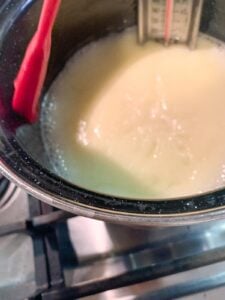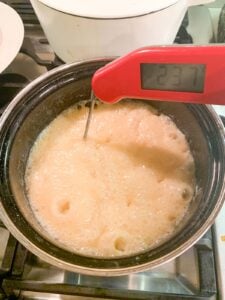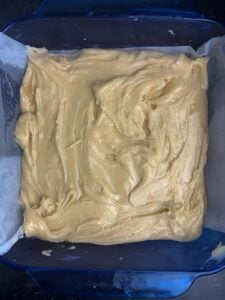Classic Old Fashioned Vanilla Fudge
A classic vanilla fudge recipe made with corn syrup to prevent crystallization. This recipe will remind you of your favorite boardwalk fudge! Serving size is one 1-inch square.
Servings: 64 pieces
Calories: 61kcal
Equipment
- Candy Thermometer or Digital Thermometer (digital preferred; recommend testing in boiling water should register 212F)
Ingredients
- 3 cups granulated sugar
- 1.5 cups heavy cream also called "heavy whipping cream"
- 1/4 cup light corn syrup
- 1/4 teaspoon salt
For the Mixing Bowl
- 1 tablespoon butter plus more for greasing pan and for greasing pot
- 1 tablespoon vanilla
Optional Add-Ins (Total of 1 Cup)
- Nuts (almonds, walnuts, pecans, etc)
- Mini marshmallows
- Chopped candies
- Coconut
- Chopped maraschino cherries make sure to dry out as much as possible.
Instructions
- Line an 8x8 pan with foil or parchment paper, then grease sides that are not covered by the paper or foil, and set aside (you can also grease the entire pan which helps the parchment paper stick)
- Set a medium sized heatproof bowl over a wire rack, and add 1 tablespoon of butter and vanilla extract. Set aside
- Set medium sized heavy-bottom pot over the stove and add sugar, heavy cream, corn syrup, and salt.

- Insert a candy or digital thermometer to monitor the temperature (see NOTE 1 below).
- Heat mixture over medium-low heat, and stir to combine until the sugar has melted. During the first 5 minutes or so, wash down the sides of the pot with a damp pastry brush to prevent sugar crystals from forming.

- You can opt to grease the sides of the pot instead of using the pastry brush to wash the sides.
- Once the mixture is homogenous and the sugar has melted, stop stirring and remove the spoon from the mixture! Otherwise, you can end up with grainy fudge.
- Raise heat until the mixture reaches a very gentle simmer.
- Continue to heat without stirring (no spoon!) until the mixture reaches 238F, aka the soft ball stage.

- For high altitude, subtract 2 degrees F for every 1000 feet about sea level (or 1 degree for every 500 feet about sea level) to determine the soft ball stage temperature.
- If you don't have a thermometer, use a bowl of ice cold water and once your fudge looks like bubbling lava, drop a teaspoon full into the cold water. Remove the fudge from the water, and squeeze it between your fingers - If it balls up into a soft ball, your fudge is ready.
- When the mixture reaches the target temperature, immediately transfer the contents to the heatproof bowl containing the butter and vanilla. Do not use a spoon to transfer and do not scrape sides or bottom of pot.
- Allow the mixture to cool undisturbed until it reaches 110F - do NOT stir while it is cooling down.

- After the mixtures has cooled (about 1.5 hours), begin stirring with a wooden spoon until it thickens and loses its gloss (10 to 15 minutes). The more continuous and plentiful the stirring, the more fine grained and smooth your fudge will be (yes, I take a few breaks!)

- Immediately transfer to prepared pan using a wooden spoon or spatula, smooth top, and let it rest on the counter for at least another hour before refrigerating.

- Refrigerate for at least 8 hours or until set, remove paper or foil, and cut into 64 square pieces.
To Store
- Store cooked fudge in an airtight container in the refrigerator up to 3 weeks. Freeze cooked and cooled fudge in an airtight, freezer-safe container for up to 3 months. Thaw frozen fudge by placing it overnight in the refrigerator.Cut the fudge into pieces before storing, and separate any layers with waxed paper or plastic wrap.
Video
Notes
- A digital thermometer is recommended for this recipe. A very common problem is the use of a candy thermometer that is not accurate.
- If you don't have a thermometer, use a bowl or glass of ice water to test for "soft ball" stage. This occurs when you place a very small amount of fudge into the ice water, it should immediately form a semi-solid mass, like a tootsie roll that is super soft.
- If you are a beginner fudge maker, don't make fudge when it's humid or raining outside. It will affect the texture of your candy.
- Do NOT stir the mixture after the initial stage where you heat the mixture to incorporate the sugar, or you risk crystallization of the sugar.
- Use very sharp knife to cut to get clean edges
- Aside from heating the fudge to the correct temperature, the next hardest part is probably beating the fudge. For this reason, it is recommended to only make one batch of this recipe at a time. Beating the fudge should take about 10 minutes.
- Don't scrape the pan when you are transferring the cooked fudge to the baking pan. otherwise, you risk the formation of sugar crystals (that will inevitably cause grainy, sandy fudge).
- Use a large enough pot so fudge won't boil over (It grows to about 3 times the volume at some points during boiling) and heavy enough so the fudge won't burn. The last thing you want is for this fudge to make a mess on your stove!
- Make sure the fudge is boiling and not merely simmering or else it will not reach the target temperature.
Nutrition
Calories: 61kcal | Carbohydrates: 11g | Protein: 1g | Fat: 2g | Saturated Fat: 1g | Trans Fat: 1g | Cholesterol: 8mg | Sodium: 14mg | Potassium: 5mg | Sugar: 10g | Vitamin A: 87IU | Vitamin C: 1mg | Calcium: 4mg | Iron: 1mg
